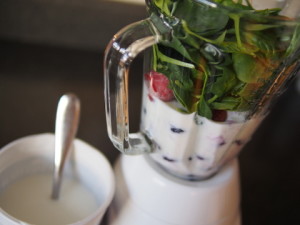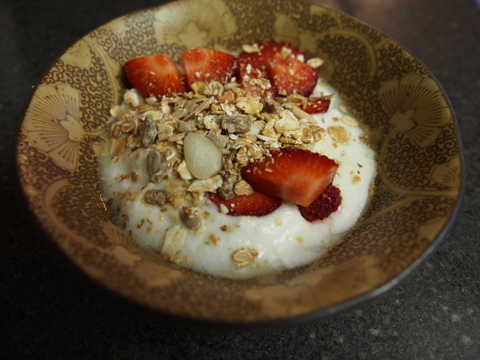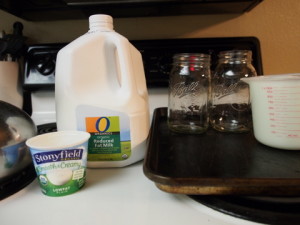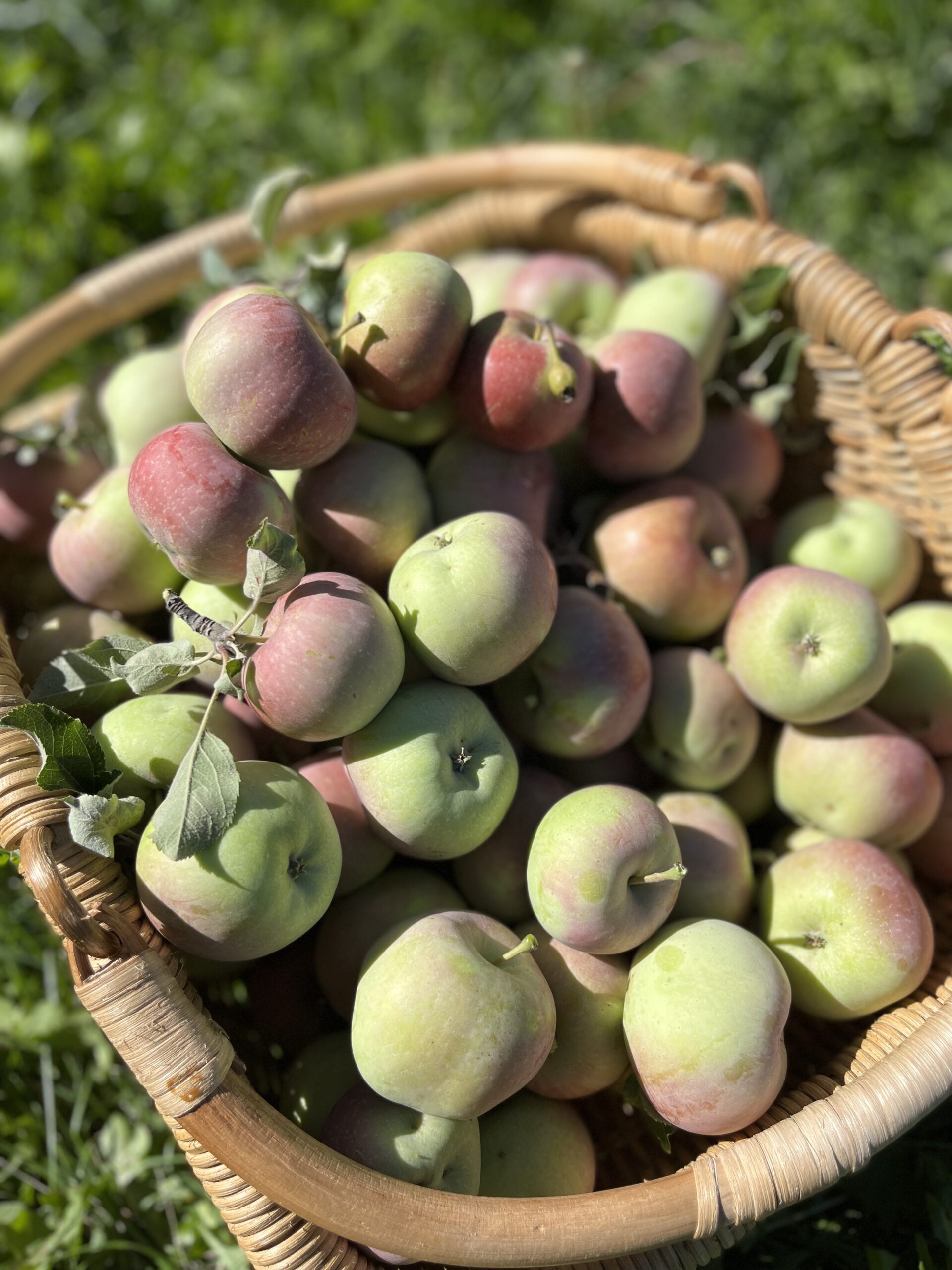 Seems like every food magazine or cookbook I open these days touts the ease and joy of making your own yogurt. Wait – What? WHY? I couldn’t see the logic so I thought I should try for myself (and for you!) to answer some basic questions: Is it worth it? Does it taste good? Is it safe? What’s the cost relative to buying in-store?
Seems like every food magazine or cookbook I open these days touts the ease and joy of making your own yogurt. Wait – What? WHY? I couldn’t see the logic so I thought I should try for myself (and for you!) to answer some basic questions: Is it worth it? Does it taste good? Is it safe? What’s the cost relative to buying in-store?
I’m going to move the bottom line up here to the top, since the rest of the post (spoiler alert!!) gives all the details and is intricate, technical, and honestly probably a bit underwhelming.
Bottom Line:
Yes, it does “work” – you can make something approximating yogurt. And definitely at least you can easily make something kinda like kefir.
No, it won’t kill you (or, I should say, it hasn’t killed me…yet!).
No, it’s not as simple as “they” would have you believe.
No, I don’t have all the answers (on this or any other matter frankly).
No, I doubt I’ll be doing it again soon.
Yes, it was a fun experiment. Thanks for asking.
Cost effective? Yeeeaaah…about half price or more if you commit to recycling your starter. Price depends on the milk and yogurt you use (organic or not, on sale or not), and how many failed attempts and experiments it takes to get it close to your personal yogurt ideal. Since it is so hands-off I’m not counting the cost of time – it is very labor un-tense. The savings here comes if you are a religious yogurt-eater. The worth comes into play if you are super committed to knowing exactly precisely what you are eating. If you eat yogurt daily and like the piece of mind knowing that it is made with the milk of your choice (and not much else) it might be worth your while to try. The savings on a weekly basis weren’t compelling enough for me personally, but of course if you extrapolate a week’s worth of yogurt savings across a year…well then you might get a number that’ll motivate you to DIY.
And of course, let’s not forget that making your own yogurt benefits the planet in that there’s no shipping, packaging, recycling, etc.
Luckily I don’t live with a scientist — Lacy says: “I don’t think I’m ever going to make my own yogurt unless the zombie apocalypse comes and I can no longer buy my favorite Greek yogurt at the store. My husband is a scientist, and his courses on immunology, parasitological, and microbiology turned him into something of a germaphobe. He has put his foot down: no fermenting milk products on the counter.” Ah ignorance! It’s bliss.
There are 101 different recipes and techniques out there, I used 2 – one from a Jamie Oliver cookbook and ultimately had success with a recipe from IFR Daily. I’d recommend googling or searching pinterest and you’ll find a wealth of ideas, opinions, and recipes. Find one that doesn’t seem too far out to you, or one for which you already have the equipment.
And here comes the fine print….
Cost analysis: 32 ounces of DIY yogurt starts with 1 quart of milk (4 cups) and 3-4T yogurt. After you get your first successful batch your cost is only 1 quart of milk if you keep it going by recycling the last 4T of batch 1 to incubate and create batch 2. In the Denver-metro milks range from $.77 pq (per quart) up to $2.24 pq. Yogurt prices range from 12-24 cents per 4 Tablespoons. So cost per 32 ounces could be anywhere between $.89-$2.48. Detailed milk and yogurt price comparison is waaaay down at the bottom in case you enjoy that kind of thing.
 Attempt #1 – I Can’t Believe it’s Not Yogurt!
Attempt #1 – I Can’t Believe it’s Not Yogurt!
For starters I followed a Jamie Oliver recipe – heated the milk (2% lucerne non-organic quarts on sale $1) to boiling, then let it cool to 107degrees. Whisked in 4 heaped Tablespoons yogurt (mountain high non-organic plain lowfat), put a lid on the pot, then let it sit on the stovetop. Started at 9:15am. After 6 hours it looked the same as at 9:15. By 5:30pm (8.25 hours) you could see something happening – thin yogurt on the bottom, milky top. Same look after 9 hours at 6:20pm. 8:33pm same thing, smelled like yogurt. By 10:30pm (13.25 hours) I had to go to bed so put the lidded pot it in the fridge. The result? It ended up like keifer in consistency. And I used it like keifer – in blueberry smoothies. The 4 cups milk resulted in 4 cups of keifer. $1.15 expenditure.
Attempt #2 – Debatable Yogurt
I foolishly still and again followed Jamie Oliver’s recipe, though I didn’t boil the milk rigorously – I let it heat to just below/before a boil (175 degrees). Then let it cool down to 106 degrees. I used Longmont Dairy (non-organic) 2% milk and FAGE greek plain yogurt. The FAGE was on sale for $1, not organic. The 4T needed used almost the whole little container’s worth. 4 cups of Longmont Dairy (non-organic) milk costs $1.44 plus the $1 yogurt and this attempt cost nearly as much as buying 32 oz of non organic yogurt from the store. This time I did the overnight method. Mixed in the yogurt at 6pm, and put it up on the stovetop til 6:30am. After those 12.5 hours the yogurt was much firmer than attempt #1, but still just on the bottom. On top was a milky layer. The yogurt beneath held together much better, seemed much yogurty-er. At 8:15am (14.25 hours later) I put it in a container and then into the fridge. The result? Still keifer-y. Used it mostly in smoothies, it wasn’t quite thick enough to stand up to granola/berries, etc. $2.44 expenditure.
This was the first attempt with organic milk, and a different method thanks to inspiration and advice from IFR Daily. Safeway O Organics ultra pasteurized 2% milk for $5.50 (on sale, with coupon). So the milk cost was $1.37 for the 4 cups needed to make 32 oz yogurt. Got a small tub of Stonyfield Organic for 89cents. This time I used 4 cups milk to just 3 heaping tablespoons of yogurt. Other innovations – glass jars, using the microwave to heat the milk, and using the oven light to keep the culture warm overnight. Microwaved the milk in a big glass bowl for 7 minutes – in 1 minute intervals, stirring between minutes – it came out at 149 degrees. Let it cool to 114 degrees. Whisked in the 3T yogurt. Put in oven on a cookie sheet, in pre-warmed glass jars (I filled them with hot water first) with lids at 9:50pm in the back of the oven right up next to the (on) oven light. 6am check up – jars still very warm! And things looked very yogurty in there! Left them in another few hours, removed to frig. The result? Tasty tasty stuff. Very much like store-bought. $1.85 expenditure (approximate).
Milks range from $.77 pq (per quart) up to $2.24 pq:
Sprouts non-organic Milk $3.49/gallon, all kinds = .87 per quart, Sprouts Organic gallons all $5.69 = 1.42 pq. Organic Valley at Sprouts $4.49 1/2 gallon = 2.24 pq. Safeway O Organics $5.49 sale gallon, 1/2 gallon 2.99 = 1.37-1.49 pq, Safeway Lucerne quarts (non organic) on sale for $1 each, Lucerne 1/2 Gal $2.19, gall $3.39 = .84-1.19 pq. Longmont Dairy (non organic but delivered and comes in glass bottles that get washed and reused…)$1.44-2.24 pq. Target house brand Simply Balanced Organic $2.54 per 1/2 gallon (coupon for $1 off dropped that down to $1.54 – a steal!) = .77-1.27 pq. Target non-organic gallons $3.29 per = .82 pq. Horizon Organic: at Sprouts 1/2 gall $3.49 sale, Gallon $6.49 = 1.62 pq; at Safeway $3.99 1/2 gallon = 1.99 pq; at Target $2.79 1/2 gallon, $7.99 per gallon = 1.4-1.99 pq.
Yogurt prices (in cp4T – cents per 4 Tablespoons) – ranges from 12-24 cp4T:
Mountain High (non-organic) at Safeway $2.99 on sale plus a doubled 50cent off manufacturer coupon makes 32 oz $1.99 = 12 cents for 4T. Safeway’s Lucerne (non-organic) yogurts $2.09 per 32 oz = 12.5 cp4T. Safeway O organics plain lowfat $3.29 per 32 oz = 19.7 cp4T. At Vitamin Cottage/Natural Grocers Straus Organic on sale $3.29 = 19.7 cp4T; Wallaby Organic $3.45 = 20.7 cp4T; Stonyfield Organic $3.49 per 32 oz = 21 cp4T. Horizon Organic 32 oz at Costco $3.59 = 21.54 cp4T. And finally Nancy’s Organic at Vit Cott/Nat Groc $3.99= 24 cp4T.




Ha HA! Thanks for going where my husband would frown for me to go…